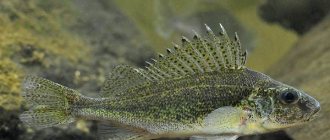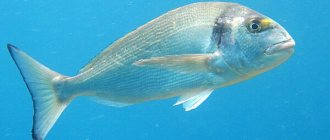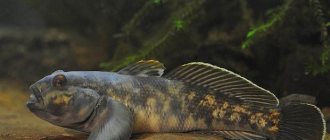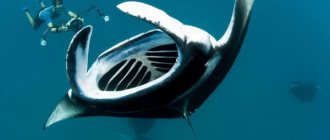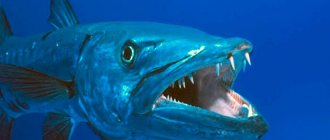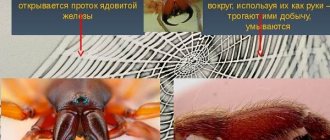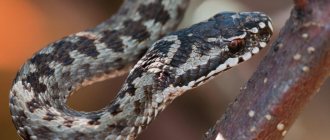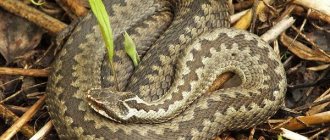Barracuda fish is one of the twenty most famous marine predators in tropical and subtropical waters.
She is the threat of all small fish, and big ones too. Barracuda is also known for attacks on people and its own relatives; and eating its meat can lead to the most tragic consequences. Have you tried barracuda?
- No 60%, 33 votes
33 votes 60%33 votes - 60% of all votes
- Yes 40%, 22 votes
22 votes 40%
22 votes - 40% of all votes
Total votes: 55
16.09.2019
- No 60%, 33 votes
33 votes 60%33 votes - 60% of all votes
- Yes 40%, 22 votes
22 votes 40%
22 votes - 40% of all votes
Total votes: 55
16.09.2019
×
You or from your IP have already voted.
Barracuda - sea pike
Barracuda fish takes pride of place in the top twenty most aggressive marine predators. In appearance and lifestyle it is similar to freshwater pike. Can grow up to 2 m. Prefers tropical and subtropical waters.
Description and features
In Italy, in the last century, fossils of a fossil fish, the ancestor of modern barracudas, were found. Scientists have determined the age to be 45 million years. The surviving remains give reason to conclude that modern barracudas differ little from their prehistoric ancestor.
The predatory essence of the fish is discernible, first of all, in the streamlined contours of the body. The body is elongated, cylindrical. Up to a quarter of the body length is occupied by a pointed head. The large mouth with a mesial bite gives the fish an unattractive appearance. Two rows of incisors leave no doubt - this is a voracious and bloodthirsty aggressor.
Color depends on the species and living conditions. The upper part of the barracuda is dark. The sides are light gray with a metallic sheen. Some species have irregular dark spots on the body. The abdomen is white-chalky. The fins are brown, sometimes yellow.
The eyes are located in the middle part of the head. The gills are covered with covers that lack spines. There are two fins on the back. The anterior one has 5 spine rays. The second has one main and nine soft rays.
Barracuda is one of the most aggressive marine predators
A pronounced lateral line runs along the entire body. The pectoral and anal fins are located at the bottom. The body ends in a powerful, distinctly branched, symmetrical tail.
Kinds
The barracuda in the photo evokes associations with mackerel in body shape and color. The reason for the similarity is simple - their relationship. Barracudas are part of the mackerel order. The classification, Latin name of the barracuda genus is Sphyraena. Therefore, fish are often called sphyrena. The most famous types of these fish:
- Great barracuda .
The fish inhabits subtropical ocean areas. They hunt at depths of less than 100 m. Their favorite places are mangroves and reefs, including the Great Barrier. The body length of an adult fish reaches 1 m. Usually less: about 60 cm. But records also happen. The largest fish caught was 2.1 m long. Some individuals accumulate a toxin in the body, which makes this species dangerous when eaten.
- A blunt-nosed sphyrene.
Found off the coast of Indonesia, Micronesia, and the Philippines at a depth of 3-30 m. Visits the coastal waters of Australia and the northern part of New Zealand. It expanded its range by moving from the Red Sea to the Mediterranean.
- European barracuda.
It has mastered the coastal, pelagic waters of the Mediterranean Sea and the Black Sea. It is the largest species of sephirenes in these waters. The northernmost region in which it is found is Bristol Bay in England. In addition, it is found in the Bay of Biscay, up to the Canary Islands, in the coastal waters of Latin and South America. Its length is usually 0.6 meters. The largest specimen caught was 1.6 meters in length and 12 kg in weight.
- Barracuda guachancho.
Off the coast of Africa from Senegal to Angola, in the Caribbean, from the American state of Massachusetts to Brazil, you can find guachancho at depths of 10 to 100 meters. In areas where barracuda are found, the fish is a commercial target.
- California barracuda.
It is also called the Pacific, silvery sphyrene. Found in the Pacific Ocean: from Mexico to Washington. Amateur fishing for this fish is popular in the Gulf of California.
- Northern barracuda.
Its range is the western part of the Atlantic. Water areas in the east of Panama, in the Gulf of Mexico, in South Florida. In the north it reaches the Canadian shores. Refers to the smallest representatives of baracudas. A length of 45-55 cm is considered the maximum for them.
- Australian barracuda.
The area corresponds to the name - the east coast of Australia to Tasmania. Found off the northern coast of New Zealand. Pelagic species. Gathers in medium-sized flocks on sandbanks. Object of amateur fishing.
- Barracuda picudilla.
Found in the Caribbean, off the coast of Florida, the Bahamas, and the coastal waters of Uruguay. For local residents, barracuda fishing is a traditional trade.
- Pelican barracuda.
She has mastered the spaces from the Gulf of California to the Galapagos Islands. It lives in small flocks of no more than two dozen individuals. The habitat depth does not exceed 30 m.
- Sharp-finned barracuda.
Small, endangered species. Lives in the Indo-Pacific region: from East Africa to Hawaii. It has mastered the pelagic zones off the coasts of Japan and China. The length of this variety is no more than 0.8 m.
- Yellowtail barracuda.
One of the smallest species. Inhabits the Indian Ocean. An adult grows up to 0.4 m. The name reflects the peculiarity of its appearance - a yellow tail. There may also be yellow tints on the sides. Engaged in the settlement of new territories. In 1992, it was first caught off the coast of Israel. In 2002 it reached the island of Rhodes, and in 2005 it was caught off the coast of Libya.
Scientists include 28 currently existing species in the genus of sephirenes. But with the systematization of barracudas, not everything is completely resolved. Some species may become subspecies. Corrections to biological systematization are made by genetic studies.
Types[edit | edit code]
There are 28 modern species of barracuda [1][3]:
- Sphyraena acutipinnis
- Sphyraena afra
- Sphyraena argentea - California barracuda, or silver barracuda
- Sphyraena barracuda - Greater barracuda
- Sphyraena borealis
- Sphyraena chrysotaenia
- Sphyraena ensis
- Sphyraena flavicauda
- Sphyraena forsteri
- Sphyraena guachancho - Guachancho
- Sphyraena helleri
- Sphyraena iburiensis
- Sphyraena idiastes
- Sphyraena intermedia[4]
- Sphyraena japonica
- Sphyraena jello—Striped barracuda
- Sphyraena lucasana
- Sphyraena novaehollandiae—Australian barracuda
- Sphyraena obtusata - Blunt barracuda
- Sphyraena picudilla
- Sphyraena pinguis - Red barracuda
- Sphyraena putnamae
- Sphyraena qenie
- Sphyraena sphyraena - European sphyrene, or small-scaled sphyrene
- Sphyraena tome
- Sphyraena viridensis
- Sphyraena waitii
- Sphyraena bognorensis † [5]
- Sphyraena bolcensis †
⭐⭐⭐⭐⭐ Material from Wikipedia - the free encyclopedia.
Lifestyle and habitat
Sphyrena, also known as barracuda, is an indiscriminate, aggressive predator. The main hunting method is ambush. Good eyesight gives it an advantage over many marine inhabitants. When swimming past potential prey, the barracuda makes a high-speed lunge. At a short distance, the predator can reach speeds of up to 45 km/h. The huge mouth and two rows of sharp teeth leave no chance for the victim.
Due to their aggressiveness and constant mood for attacking actions, large fish prefer solitude, but some smaller species unite in schools. The method of ambush hunting dictates the choice of living space. Barracuda prefers reef landscapes, mangrove forests, an abundance of algae or turbid waters at the confluence of rivers and seas.
Barracuda has two rows of teeth: external and internal.
In case of poor visibility, the predator sometimes makes mistakes: it attacks objects significantly larger than it in size. This may explain the rare episodes of barracuda attacks on humans.
a program that is necessary for every enterprise.
Tweet
Barracuda - characteristics, use in cooking. Barracuda - belongs to the genus of marine fish, belongs to the order of perciformes, which stand out in themselves in the family Barracuda.
Barracuda - a distinctive feature of this fish is its powerful, protruding upper and lower jaw.
Barracuda - Another common name for barracuda is the sphyrene or sea pike, due to its external similarity to the common pike. Although barracuda is called sea pike, the similarity between these two fish is purely external and does not at all indicate their relationship. The closest relatives of the barracuda are the peaceful mullet.
The barracuda's body has a similar structure to that of the common pike, with small scales, short fins on the back, and a wide mouth with sharp teeth.
Barracuda, like all types of marine fish, is extremely beneficial for the human body. Only the meat of young barracuda, whose size has not reached sixty centimeters and weighs up to one and a half kilograms, is used for food. In Japanese cuisine, barracuda meat is highly valued for its taste. In Australian cuisine, barracuda fish is considered one of the national dishes. Barracuda can be eaten either raw or cooked, usually served in combination with sauce and boiled rice.
Barracuda meat contains all the amino acids necessary for the human body and the most valuable amino acid, taurine. Taurine regulates human blood sugar levels, stimulates the release of insulin, and prevents the development of hypertension.
It is very important not to eat the meat of barracuda, which has grown more than sixty centimeters in length, and if the barracuda has reached two meters in length, it is poison for humans
Barracuda meat becomes toxic due to the fact that an adult barracuda for a long time feeds on plankton, which contains toxic substances, and consumes poisonous pufferfish.
Use in cooking:
In cooking, as mentioned above, small barracudas, up to one and a half kilograms, are used for preparing dishes. To prepare fish, you can use any heat treatment: fry, stew, bake. You can cook fish from pure fillet without skin, but experts say that it is the skin that gives barracuda dishes the necessary smell and fat content.
The small barracuda is very tasty stuffed whole or baked on the grill.
Fried barracuda fillet with salad.
Cooking technology:
Cleaned and prepared barracuda, filleted and cut into strips of four to five centimeters.
Mix two types of flour and dilute in water to a homogeneous consistency of thick sour cream, salt and pepper the resulting mass.
Pour olive oil into a deep frying pan and heat it. Dip sliced barracuda fillet strips in batter and fry in hot oil until golden brown.
Place the finished fish on a dish, place a salad of fresh vegetables next to it and serve.
In the article we looked at a brief description of barracuda fish and some of its uses in cooking. If you liked the article and found it useful, please leave your comments.
See you soon.
Nutrition
The diet includes small fish of any kind, including: anchovies, mackerel, herring. Barracudas attack squids. Able to cope with pufferfish. Do not neglect shrimp and other crustaceans.
Sphyrena is capable of tearing prey into pieces, so it attacks large fish and animals. Can attack young dolphins that have strayed from the herd. It does not disdain cannibalism: it attacks its own juveniles and adults.
The sea pike itself can fall into the hands of the cook. The answer to the question “ are barracuda fish edible or not ” is, in principle, positive. But poisoning has occurred when eating large barracuda. The poison ciguatoxin accumulates in the body of some reef barracudas. A person who eats such fish may experience symptoms of poisoning, including paralysis.
Barracuda hunts fish, chasing them at a speed of about 50 km/h
A cook preparing barracuda must understand its types. Californian sphyrena, for example, is never toxic. In Cuba, a simple method is used. Barracuda meat is given to a cat. If after a couple of hours nothing happens to it, then you can eat the fish.
How to choose
When choosing fish in a store or market, questions arise: is it possible to eat barracuda, is it really edible? The answer is definitely yes. You just need to take into account that only small young individuals are suitable for food.
Important! Barracudas longer than 60 cm and weighing more than 1.5 kg are not edible. And a two-meter (or longer) fish is pure poison for humans.
Toxins accumulate in the meat of the sphyrene due to its consumption of plankton, which filters toxic substances from the water. Toxins accumulate in the greatest quantities in milk, liver and fins of fish. The older and larger the predator, the more toxic it is.
Reproduction and lifespan
At the age of two, barracudas can continue the race. Shallow waters and shallows are chosen as spawning grounds. The spawning season varies for different populations. The onset of the breeding season is associated with changes in water temperature in the area where the fish live.
Fish gather in groups for a short period. Females lay eggs in the water without resorting to tricks or caring about their safety. Males, releasing milk, fertilize the eggs. This is where parental care for future barracudas ends.
The caviar is actively eaten by other marine life. It is possible that parents themselves participate in this process. The survival rate of the eggs and the young that hatch from them is very small. But sufficient to confidently maintain the number of sephiren. A young female can give birth to 50 thousand, an older individual - 200 thousand eggs.
In populations living near mangrove forests, spawning occurs not in open water, but in backwaters. Under the protection of the mangroves, the fry are born. In flocks, young animals reach adolescence and only then begin to lead an independent life.
The life expectancy of sephirens is quite long, from 12 to 20 years, depending on the species. Despite active fishing, the barracuda is not in danger of extinction. Ichthyologists note a decrease of several percent in the average length of Mediterranean barracudas. This may indicate degradation of the species.
Aggressive inhabitants of the Red Sea
In addition to peaceful, safe fish, the waters of the Red Sea also contain dangerous, aggressive species. At the same time, they are not the first to attack, but if they are provoked, you may regret it. As a rule, when blood appears, predators always appear immediately, so following simple rules can help protect a person from unforeseen situations.
That's why:
- Do not touch fish with your hands.
- Do not visit the sea at night.
At the same time, you must always be prepared for the fact that a fish may unexpectedly attack an underwater swimmer.
Price
The danger of poisoning exists only when eating large barracudas. All commercial species are safe. Therefore, fish is prepared and served in restaurants in many countries. There are many barracuda dishes. From grilled steaks to smoked meats.
In our country it is sold in large fish stores. The price of barracuda is 250...300 rubles. By paying this amount per kilogram of frozen fish, you can try yourself as a creator of exotic fish dishes.
Barracuda very rarely attacks people
Commercial value
Today, barracuda is quite actively caught not only for sporting purposes, but also for industrial purposes. Adult and large barracudas are fearless aquatic predators, therefore they have practically no natural enemies in their natural habitat, with the exception of humans.
The meat of predatory fish is processed by all currently known methods. Barracuda can be fried, stewed, and also boiled and baked in the oven or on the grill.
Dishes are also prepared from fillet, which is first completely deprived of bones and skin. However, true gourmets and seafood connoisseurs believe that it is the skin that can give fish dishes a unique and very original aroma, taste and fat content. Particularly popular is fillet fried in batter and served with salads or fresh vegetables.
Return to content


